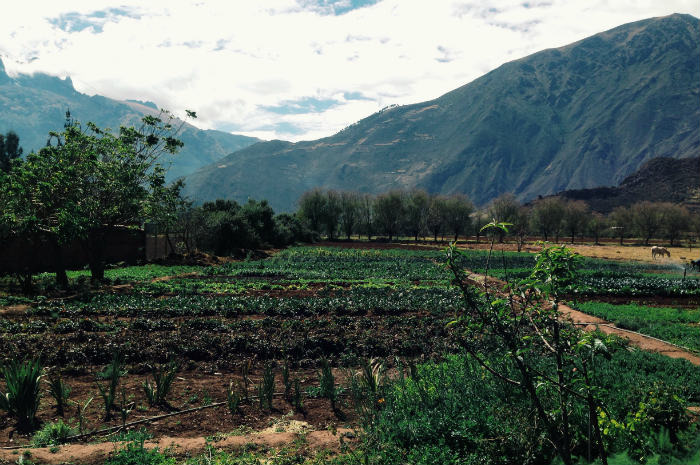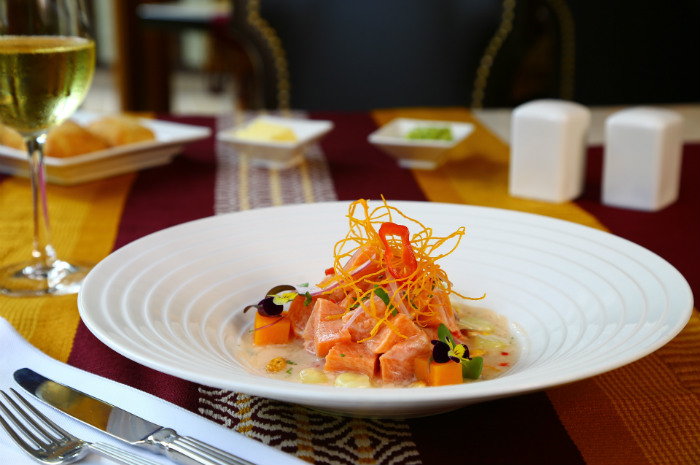Why Peru Is, And Always Has Been, The Culinary Capital Of South America
When I ask our host, general manager of Sumaq Machu Picchu Hotel, Angie Clavijo, what she likes to do when she's at home in Lima, she casually responds: "I like to go out and eat." In Peru, eating is a way of life. I came here to explore some of the country's most popular regions – Machu Picchu, the Sacred Valley, Cusco and Lima. It didn't start out as a food-lover's trip, but it quickly became one. Good food isn't new to Peru. In a country home to 3,000 different types of potatoes, where ceviche is the national dish and quinoa has long been a staple, it's no surprise that food has always been the main ingredient in Peruvian culture.
I arrive in Aguas Calientas, the town at the base of Machu Picchu, and collapse into a chair in the hotel lobby before ordering a pisco sour — a zesty cocktail made from pisco (a liquor distilled from grapes), which Clavijo tells me is "the national drink of Peru." It's no small feat getting from New York City to Aguas Calientas, but we've made it and I think I deserve a drink — especially if it's Peru's national drink. We are staying at the luxury hotel that overlooks one of the mountains surrounding the world-renowned Incan citadel, Machu Picchu. As exhausted as I am and as much as I need a shower, the first thing I want to do is sink my teeth into some ceviche. Peru is renowned for its ceviche, and seeing as I'm already enjoying the national drink, I might as well go with the national dish, too.
Although Sumaq doesn't market itself as a food-lover's destination, it should. We settle for lunch at the hotel restaurant and order an array of dishes from the menu. We eat everything from classic ceviche – made with local salmon trout (also known as Rainbow trout) caught in Lake Titicaca, to pastel de choclo – a traditional corn pie filled with oxtail and paria cheese. Later, we are given a cooking demonstration where one of the chefs shows us how to make ceviche and one of the bartenders shows us how to make a pisco sour. Making ceviche isn't hard, but there is a certain level of skill involved. The chef uses salt, chili, lemon, lime juice, lots of ice cubes and a celery paste, which she tells us is her family's secret recipe. With most Peruvian recipes, the ingredients are never complicated – just really, really good.
The next morning is spent hiking around the beautiful Incan ruins of Machu Picchu. Afterwards, we are treated to a pachamanca, a traditional Peruvian dish which is baked in the earth with hot stones. By the time we arrive, the food has been cooking for around three hours and is almost ready to be served. We watch as the chefs remove the earth, grass and stones to display an underground oven, where meat wrapped in banana leaves and several varieties of potato have been cooking. We are served a cup of chicha de jora, a fermented corn beer, which although rich and funky, is strangely moreish. We sit down to lunch where the potatoes and corn are served separately and the meat is served as a stew in a small clay pot. I count six different types of potato on my plate. To accompany it, we drink Cuzqueña, a local Cuzco beer – the perfect addition to a hearty meal, after a morning of hiking.
The next day we bid farewell to Machu Picchu and Aguas Calientas, and make our way by rail to the town of Ollyantantambo. From here we are driven to the Sacred Valley, or Valley of the Incas. Set at the foothills of the Andes, the valley is a strangely desolate place dotted with towns and Incan ruins. We stop in at Aranwa Hotel and wellness center, where we eat a lavish dinner featuring an assortment of traditional Peruvian dishes, in a seventeenth century courtyard. The hotel has its own garden where they grow all their own vegetables and herbs. The valley is incredibly fertile, "you drop something and it grows," one of the gardeners tells me. Clearly, this is why the valley is so sacred.
Our next destination is Cusco, a city in the Andes that was once the capital of the Incan empire. It's a spectacular city, steeped in history, which sits 1,1000 feet above sea level. Here, altitude sickness is no joke. Our hotel, the JW Marriot, set in an old convent built over preserved Inca ruins, even pumps oxygen into the rooms. I sip on coca tea, an ancient herbal tea from the coca plant, which is rumored to prevent altitude sickness.
After a day of sightseeing with Viajes Pacifico Agency, we visit a local market and marvel at the products: chuño (dehydrated potato), chuta (handmade bread) and salted lamb (similar to jerky). Despite being told that the altitude decreases your appetite, we stop for a 3-course lunch at MAP café. Set in a courtyard at the Museo de Arte Precolombino, MAP serves Peruvian haute cuisine. I opt for crayfish ceviche (which is served hot) and an Amazonian fish, paiche, which is poached in olive oil. One of the best dishes to arrive at the table is the quinoa cannelloni, with truffle essence, tomato pesto and sautéed vegetables – it's incredible what the Peruvians can do with such a simple grain. [pullquote:right]
A three-course meal at lunch isn't the best idea when you're set to eat a full tasting menu at dinner, but the food in Peru is so good, you can't possibly miss out on any opportunity to try a new dish. That evening, we dine at the hotel restaurant. Our tasting menu includes everything from fried Andean cheese to alpaca steak and cuy (guinea pig) with corn puree. Guinea pig is considered a delicacy in Peru, and although I find the meat slightly tough, I really enjoy the alpaca – despite having petted one earlier that morning.
Our final destination is Lima, a city I've wanted to explore for quite some time. Lima is exploding on the culinary scene, with restaurants such as Central and Maido gaining international attention and making it onto the World's 50 Best Restaurants list. We check in to the Wyndam Costa del Sol Lima, a newly refurbished hotel which has a lobby filled with bright Marimekko-upholstered chairs, and make our way straight to dinner at Maras restaurant. The chef, Rafael Piqueras, whose résumé includes El Bulli, is also responsible for devising the menu at Sumaq Machu Picchu Hotel. We are seated in a private dining room where we are served a tasting menu, which includes raw scallops, avocado gazpacho, grilled octopus and lucuma, a subtropical fruit native to the area. It's a serious fine-dining experience where courses are served in everything from a little wooden box, to a glass plate, and even something that resembles a whale bone.
Our final day in Lima includes a city tour and one last meal at Museo Larco Café, the museum restaurant which was once run by Gaston Acurio. Although it's almost physically impossible to fit any more food in my stomach, I can't miss out on my final meal in Peru. I opt for a quinoa dish, which is deep and nutty, and comes with an entire avocado, which is rich and buttery. It's a final reminder of how exceptional the quality of ingredients is here. I think back to what our Limeñan guide, Amalia, had told us on our tour earlier that morning "If you come here with open eyes and an open heart, you can experience everything". Only, I think she left out the part about coming with an empty belly, too.
LAN Airlines has 9 flights a week from New York to Lima and around 18 to 20 daily flights from Lima to Cusco. During high season, LAN Airlines offers 23 daily flights from Lima to Cusco. LAN also has nonstop flights from LAX to Lima.


